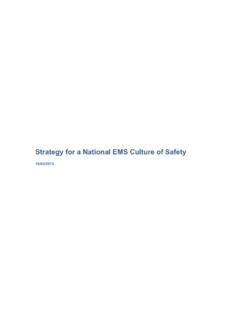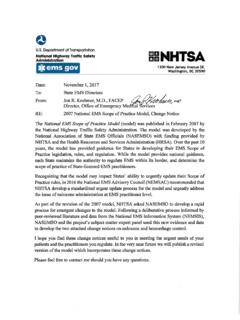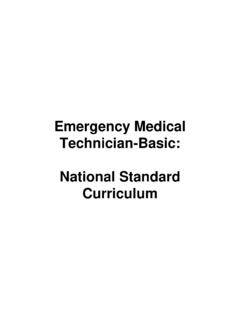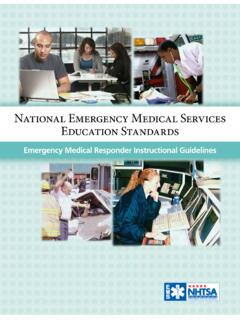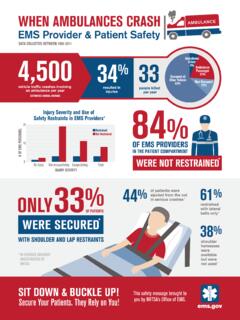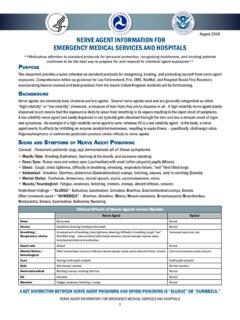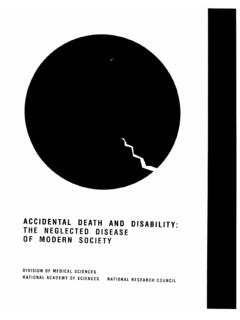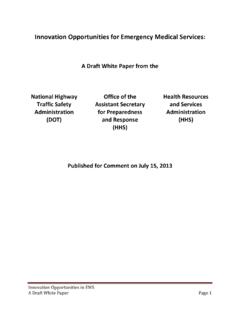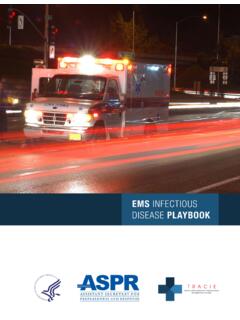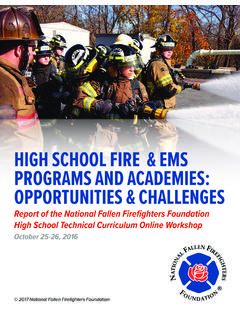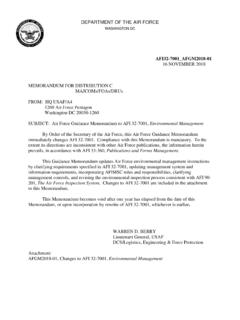Transcription of Beyond EMS Data Collection
1 Beyond EMS data Collection : Envisioning an Information-Driven Future for Emergency Medical Services This publication is distributed by the Department of Transportation, national Highway Traffic safety Administration, in the interest of information exchange. The opinions, findings, and conclusions expressed in this publication are those of the authors and not necessarily those of the Department of Transportation or the national Highway Traffic safety Administration. The United States Government assumes no liability for its contents or use thereof. If trade or manufacturers names or products are mentioned, it is because they are considered essential to the object of the publication and should not be construed as an endorsement. The United States Government does not endorse products or manufacturers. Suggested APA Format Citation: Becknell, J., Simon, L. (2016, December). Beyond EMS data Collection : Envisioning an information-driven future for Emergency Medical Services (Report No.)
2 DOT HS 812 361). Washington, DC: national Highway Traffic safety Administration. i Technical Report Documentation Page 1. Report No DOT HS 812 361 2. Government Accession No. 3. Recipient s Catalog No. 4. Title and Subtitle Beyond EMS data Collection : Envisioning an Information-Driven Future for Emergency Medical Services 5. Report Date December 2016 6. Performing Organization Code 7. Author/s John Becknell, ; Lauren Simon, MFA 8. Performing Organization Report No. 9. Performing Organization Name and Address 10. Work Unit No. (TRAIS) The Event Planning Group 8720 Georgia Avenue, Suite 801 Silver Spring, MD 20910 11. Contract or Grant No. DTNH22-15-F-00103 12. Sponsoring Organization Name and Address national Highway Traffic safety Administration 1200 New Jersey Avenue SE. Washington, DC 20590 13. Type of Report and Period Covered Final Report 14. Sponsoring Agency Code Office of Emergency Medical Services (NPD-400) 15. Supplementary Notes Noah Smith, MPH. served at the NHTSA Contracting Officer s Representative for this project.
3 16. Abstract Beyond EMS data Collection : Envisioning an Information-Driven Future is the result of 10 months of work and study by a committee formed by the NHTSA Office of EMS to lend its expertise to the issue of data and information use in EMS. The summit meeting was held in July 2016. Nearly 50 participants representing a variety of national EMS organizations joined the committee in discussing the current state of data use in EMS and ways in which it might be improved. The goal of the summit was to envision a future in which EMS at all levels is inspired to collect and use data to drive meaningful change, and identify tactics for realizing such a future. This document summarizes the findings of the committee as well as discussions at the summit meeting. It is not a consensus document. Rather, it is intended to provide feedback to the EMS community on the issues, to provide guidance to EMS leaders, and to provide valuable information for the revision of relevant sections of the 1996 EMS Agenda for the Future.
4 17. Key Words emergency medical services, EMS, data Collection , information, improvement, NEMSIS 18. Distribution Statement This report is available free of charge through the NHTSA EMS website: 19. Security Classification (of this report) Unclassified 20. Security Classification (of this page) Unclassified 21. No. Of Pages 43 22. Price Form DOT F (8-72) ii Project Study Committee John Becknell, Committee Chair Chris Dillie, Committee Member Marianne Gausche-Hill, Committee Member Frank Gresh, Committee Member Kathleen Lester, Committee Member Aarron Reinert, Committee Member Todd Stout, Committee Member Lauren Simon, Project Writer Noah Smith, national Highway Traffic safety Administration, Office of EMS Rachel Abbey, Department of Health and Human Services, Office of the national Coordinator for Health Information Technology July 12, 2016, EMS data Summit Participants Rachel Abbey, Department of Health and Human Services, Office of the national Coordinator for Health Information Technology, Program Analyst Robert Bass, Retired EMS physician and State EMS director, representing EMS Compass Project John Becknell, SafeTech Solutions Thomas Breyer, International Association of Fire Fighters, Director of Fire and EMS Operations Kathy Brown, Children s national Medical Center.
5 Representing American College of Emergency Physicians Mike Brown, NHTSA Sean Caffrey, University of Colorado EMS Section Programs Manager, representing national EMS Management Association Donna Clark, Golden Hour, VP of Customer Relationship Management, representing Association of Air Medical Services Jennifer Correa, American Medical Response Clinical data Analyst Remle Crowe, national Registry of EMTs, EMS Research Fellow Chip Decker, Richmond Ambulance Authority CEO, representing American Ambulance Association Chris Dillie, ESO Solutions, President James Dinsch, Indian River State College EMS Department Chair, representing national Association of EMS Educators Elizabeth Edgerton, Department of Health and Human Services, Health Resources and Services Administration, Maternal Child Health Bureau, Director of the Division of Child, Adolescent and Family Health Michael Ely, University of Utah Department of Pediatrics NEDARC Director Jonathon Feit, Beyond Lucid Technologies, CEO Raymond Fowler, University of Texas Southwestern Division of EMS, Chief, representing the Society of Academic Emergency Medicine Marianne Gausche-Hill, Los Angeles County EMS Medical Director Mark Gestring, University of Rochester Strong Regional Trauma Center Medical Director, representing Fellow of the American College of Surgeons Cathy Gotschall, NHTSA Office of EMS Joe Graw, ImageTrend, VP of Client Services Frank Gresh, EMSA, Chief Information Officer iii Tim Hakamaki, Physio-Control data Solutions, Senior Director of data Solutions Holly Hedegaard, Centers for Disease Control and Prevention, national Center for Health Statistics Jonathan Kamrud, Allina Health EMS, Operations Supervisor Jeremy Kinsman, NHTSA Office of EMS Julie Leonard, Nationwide Children s Hospital Center for Injury Research and Policy Director of Clinical Research, representing American Academy of Pediatrics Kathy Lester.
6 Healthcare attorney representing American Ambulance Association Marty Link, South Dakota Office of Rural Health, Assistant Administrator Clay Mann, University of Utah Pediatric Critical Care/IICRC, representing NEMSIS Technical Assistance Center Gregg Margolis, Department of Health and Human Services, Office of the Assistant Secretary for Preparedness and Response, Director of the Division of Health System Policy John Marshall, NHTSA Mike McEvoy, International Association of Fire Chiefs Susan McHenry, NHTSA Office of EMS Greg Mears, ZOLL, Medical Director Richard Mosteller, Golden Hour, Senior VP of Business Development Kevin Munjal, Mt. Sinai Health System, Associate Medical Director of Prehospital Care, Promoting Innovation in EMS Project Co-Director Lindsey Narloch, North Dakota Department of Health Division of EMS, data Coordinator Aarron Reinert, Lakes Region EMS John Russell, Cape Country Ambulance, representing Professional Standards Committee (co-chair)
7 And American Ambulance Association Jules Scadden, Lisbon-Mount Vernon Ambulance Service Lauren Simon, SafeTech Solutions Noah Smith, NHTSA Office of EMS Lee Stevens, Department of Health and Human Services, Office of national Coordinator for Health Information Technology Kyle Thornton, New Mexico EMS Bureau Chief, representing national Association of State EMS Officials Dan Voss, Tritech Software Systems, Product Manager Gamunu Wijetunge, NHTSA Office of EMS Don Wood, Utah Department of Health, Office of Primary Care and Rural Health, Director, representing national Organization of State Offices of Rural Health Matt Zavadsky, MedStar Mobile Healthcare, representing national Association of EMTs iv Table of Contents Page Envisioning an Information-Driven Future .. 1 Project Process and Summit Meeting .. 2 Where We ve Been: The History and Background of data in EMS .. 3 Where We Are Today .. 9 Envisioning an Information-Driven Future .. 15 Appendix A: Terms and Definitions.
8 28 Appendix B: Timeline of Federal EMS data Efforts .. 30 Appendix C: NEMSAC Advisory on NEMSIS .. 33 Appendix D: Reading List .. 35 1 Envisioning an Information-Driven Future In a rapidly changing world, timely and accurate information is essential to good decision-making. Emergency medical services (EMS) providers, organizations, payers, local officials, State governments, Federal agencies, and the general public need reliable, valid and accurate information about EMS systems in order to effectively care for patients and participate in public policy decision-making processes. Local EMS agency and system leaders need business information to effectively and efficiently deliver optimum patient care. Similarly, EMS field personnel need real-time data and feedback on their performance to best serve their patients. EMS leaders, groups and governments have recognized this need for more than two decades, resulting in a variety of initiatives, projects and services that have led to noteworthy improvements in the way data are collected and used in EMS.
9 Most States and territories participate in the Collection of EMS records; and most submit all or part of that data to the national EMS Database, a component of the national EMS Information System (NEMSIS). However, improvements are needed to ensure that EMS truly becomes information-driven and translates its accomplishments into meaningful improvement. The path forward calls for: a renewed emphasis on and clarity about data and information use in EMS, the creation of an information culture, and ongoing information system development and Project Process and Summit Meeting This paper is the result of 10 months of work and study by a committee formed by the NHTSA Office of EMS (OEMS) to lend its expertise to the issue of data and information use in EMS. The committee was led by John Becknell, , and consisted of two EMS software vendors, an EMS physician medical director, two EMS managers, an EMS attorney, two government officials and a project writer. The committee met several times by phone and two times in Washington, DC, to discuss the issues and plan a summit meeting about data and information use in EMS.
10 The summit meeting was held in July 2016. Nearly 50 invited guests representing a variety of national EMS organizations joined the committee in discussing the current state of data use in EMS and ways in which it might be improved. The goal of the summit was to envision a future in which EMS at all levels is inspired to collect and use data to drive meaningful change, and identify tactics for realizing such a future. The summit was prompted by several initiatives, including: The 2013 publication of a Federal Advisory on EMS data by the national EMS Advisory Council (NEMSAC) (see Appendix C ); The 2013 publication of the Federal Interagency Committee on EMS (FICEMS) Strategic Plan that includes a goal of data -driven and evidence-based EMS systems to promote improved patient care quality ; A 2014 request by the Joint national EMS Leadership Forum (JNEMSLF) to the Federal Interagency Committee on EMS (FICEMS) and NHTSA OEMS to create an EMS data Collection and Information Sharing Agenda for the Future; and A 2014 recommendation by NEMSAC that FICEMS and NHTSA OEMS revise the 1996 EMS Agenda for the Future.
